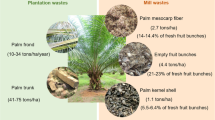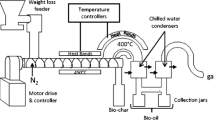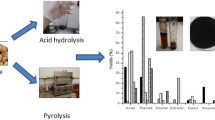Abstract
The residues from the palm oil industry are the main contributors to biomass waste in Malaysia, and these wastes require extra attention with respect to handling. The biomass waste is a renewable resource that can potentially be used to produce absorbents, fuels, and chemical feedstocks through the pyrolysis process. In this study, the wastes of palm shell, empty fruit bunches, and mesocarp fiber were characterized and then pyrolyzed in a fixed-bed reactor under the following conditions: a temperature of 500 °C, a nitrogen flow rate of 2 L/min and reaction time of 60 min. After pyrolysis, characterization of the products with an emphasis on the bio-oil and the bio-char was performed using various approaches (including Karl Fischer water-content tests, FTIR, SEM, TGA and CNH/O analyses). The results showed that the pyrolysis of palm oil wastes yielded more bio-oil than bio-char or non-condensable gases. The results also indicated that all of the bio-oils were acidic and contained high levels of oxygen. The bio-oils heating values were low and varied from 10.49 MJ/kg to 14.78 MJ/kg. The heating values of the bio-chars (20–30 MJ/kg) were higher than those of the bio-oils. Among the biomasses studied in this work, palm shell contained the highest level of lignin and showed the highest levels of bio-char yield and fixed and elemental carbon in the raw and bio-char form.





Similar content being viewed by others
References
Moreira JXC (2006) Global biomass energy potential. Mitig Adapt Strateg Glob Chang 11(2):313–333. doi:10.1007/s11027-005-9003-8
Cheung K-Y, Lee K-L, Lam K-L, Chan T-Y, Lee C-W, Hui C-W (2011) Operation strategy for multi-stage pyrolysis. J Anal Appl Pyrol 91(1):165–182
Zheng J-L (2007) Bio-oil from fast pyrolysis of rice husk: yields and related properties and improvement of the pyrolysis system. J Anal Appl Pyrol 80(1):30–35
Mohan D, Pittman CU, Steele PH (2006) Pyrolysis of wood/biomass for bio-oil: a critical review. Energ Fuel 20(3):848–889. doi:10.1021/ef0502397
Bridgwater AV, Peacocke GVC (2000) Fast pyrolysis processes for biomass. Renew Sust Energ Rev 4(1):1–73
Czernik S, Bridgwater AV (2004) Overview of applications of biomass fast pyrolysis oil. Energ Fuel 18(2):590–598. doi:10.1021/ef034067u
Ertaş M, Hakkı Alma M (2010) Pyrolysis of laurel (Laurus nobilis L.) extraction residues in a fixed-bed reactor: Characterization of bio-oil and bio-char. J Anal Appl Pyrol 88(1):22–29
Özbay N, Apaydın-Varol E, Burcu Uzun B, Eren Pütün A (2008) Characterization of bio-oil obtained from fruit pulp pyrolysis. Energy 33(8):1233–1240
Lu Q, Li W-Z, Zhu X-F (2009) Overview of fuel properties of biomass fast pyrolysis oils. Energ Convers Manage 50(5):1376–1383
Guo X, Wang S, Wang Q, Guo Z, Luo Z (2011) Properties of bio-oil from fast pyrolysis of rice husk. Chinese J Anal Chem 19(1):116–121
Horne PA, Williams PT (1994) Premium quality fuels and chemicals from the fluidised bed pyrolysis of biomass with zeolite catalyst upgrading. Renew Energ 5(5–8):810–812
Bridgwater T (2006) Biomass for energy. J Sci Food Agr 86(12):1755–1768. doi:10.1002/jsfa.2605
Uzun BB, Apaydin-Varol E, Ateş F, Özbay N, Pütün AE (2010) Synthetic fuel production from tea waste: characterisation of bio-oil and bio-char. Fuel 89(1):176–184
Katyal S, Thambimuthu K, Valix M (2003) Carbonisation of bagasse in a fixed bed reactor: influence of process variables on char yield and characteristics. Renew Energ 28(5):713–725
Mullen CA, Boateng AA, Goldberg NM, Lima IM, Laird DA, Hicks KB (2010) Bio-oil and bio-char production from corn cobs and stover by fast pyrolysis. Biomass Bioenerg 34(1):67–74
Goh CS, Tan KT, Lee KT, Bhatia S (2010) Bio-ethanol from lignocellulose: status, perspectives and challenges in Malaysia. Bioresource Technol 101(13):4834–4841
Sudirman LI, Sutrisna A, Listiyowati S, Fadli L, Tarigan B (2011) The potency of oil palm plantation wastes for mushroom production. Proceedings of the 7th International Conference on Mushroom Biology and Mushroom Products, France, 383–389
Mekhilef S, Saidur R, Safari A, Mustaffa WESB (2011) Biomass energy in Malaysia: current state and prospects. Renew Sust Energ Rev 15(7):3360–3370
Abnisa F, Wan Daud WMA, Sahu JN (2011) Optimization and characterization studies on bio-oil production from palm shell by pyrolysis using response surface methodology. Biomass Bioenerg 35(8):3604–3616
Bridgwater AV (1999) Principles and practice of biomass fast pyrolysis processes for liquids. J Anal Appl Pyrol 51(1–2):3–22
Bertero M, de la Puente G, Sedran U (2011) Fuels from bio-oils: bio-oil production from different residual sources, characterization and thermal conditioning. Fuel. doi:10.1016/j.fuel.2011.08.041
Luangkiattikhun P, Tangsathitkulchai C, Tangsathitkulchai M (2008) Non-isothermal thermogravimetric analysis of oil-palm solid wastes. Bioresource Technol 99(5):986–997. doi:10.1016/j.biortech.2007.03.001
Sulaiman F, Abdullah N (2011) Optimum conditions for maximising pyrolysis liquids of oil palm empty fruit bunches. Energy 36(5):2352–2359
Buckley TJ (1991) Calculation of higher heating values of biomass materials and waste components from elemental analyses. Resour Conserv Recy 5(4):329–341
Mott RA, Spooner CE (1940) The calorific value of carbon in coal: the Dulong relationship. Fuel 19:242–251
Williams PT, Besler S (1993) The pyrolysis of rice husks in a thermogravimetric analyser and static batch reactor. Fuel 72(2):151–159
Omar R, Idris A, Yunus R, Khalid K, Aida Isma MI (2011) Characterization of empty fruit bunch for microwave-assisted pyrolysis. Fuel 90(4):1536–1544
Yang H, Yan R, Chen H, Lee DH, Liang DT, Zheng C (2006) Mechanism of palm oil waste pyrolysis in a packed bed. Energy Fuel 20(3):1321–1328. doi:10.1021/ef0600311
Yang H, Yan R, Chen H, Lee DH, Zheng C (2007) Characteristics of hemicellulose, cellulose and lignin pyrolysis. Fuel 86(12–13):1781–1788
Leng LY, Husni MHA, Samsuri AW (2011) Comparison of the carbon-sequestering abilities of pineapple leaf residue chars produced by controlled combustion and by field burning. Bioresour Technol 102(22):10759–10762
Bridgwater AV (2012) Review of fast pyrolysis of biomass and product upgrading. Biomass Bioenerg 38:68–94
Asadullah M, Anisur Rahman M, Mohsin Ali M, Abdul Motin M, Borhanus Sultan M, Robiul Alam M, Sahedur Rahman M (2008) Jute stick pyrolysis for bio-oil production in fluidized bed reactor. Bioresource Technol 99(1):44–50
Sınağ A, Uskan B, Gülbay S (2011) Detailed characterization of the pyrolytic liquids obtained by pyrolysis of sawdust. J Anal Appl Pyrol 90(1):48–52
Zheng J-L (2008) Pyrolysis oil from fast pyrolysis of maize stalk. J Anal Appl Pyrol 83(2):205–212
Mahmood ASN, Brammer JG, Hornung A, Steele A, Poulston S (2012) The intermediate pyrolysis and catalytic steam reforming of Brewers spent grain. J Anal Appl Pyrol (0). doi:10.1016/j.jaap.2012.09.009
Ali I, Basit MA (1993) Significance of hydrogen content in fuel combustion. Int J Hydrogen Energ 18(12):1009–1011
Şensöz S, Kaynar İ (2006) Bio-oil production from soybean (Glycine max L.); fuel properties of bio-oil. Ind Crop Prod 23(1):99–105. doi:10.1016/j.indcrop.2005.04.005
Williams PT, Nugranad N (2000) Comparison of products from the pyrolysis and catalytic pyrolysis of rice husks. Energy 25(6):493–513. doi:10.1016/S0360-5442(00)00009-8
Williams PT, Reed AR (2003) Pre-formed activated carbon matting derived from the pyrolysis of biomass natural fibre textile waste. J Anal Appl Pyrol 70(2):563–577. doi:10.1016/S0165-2370(03)00026-3
Yang H, Yan R, Chen H, Lee DH, Zheng C (2007) Characteristics of hemicellulose, cellulose and lignin pyrolysis. Fuel 86(12–13):1781–1788
Prabir B (2010) Chapter 3 - pyrolysis and torrefaction. In: Biomass gasification and pyrolysis. Academic, Boston, pp 65–96
Bilgen S, Kaygusuz K (2008) The calculation of the chemical exergies of coal-based fuels by using the higher heating values. Applied Energy 85(8):776–785. doi:10.1016/j.apenergy.2008.02.001
Akkaya AV (2009) Proximate analysis based multiple regression models for higher heating value estimation of low rank coals. Fuel Process Technol 90(2):165–170. doi:10.1016/j.fuproc.2008.08.016
Acknowledgements
The authors would like to thank the University of Malaya for fully funding the work described in this publication through the Bright Sparks Program, the Postgraduate Research Grant, and the HIR Grants (D000011-16001 and D000020-16001).
Author information
Authors and Affiliations
Corresponding author
Rights and permissions
About this article
Cite this article
Abnisa, F., Arami-Niya, A., Daud, W.M.A.W. et al. Characterization of Bio-oil and Bio-char from Pyrolysis of Palm Oil Wastes. Bioenerg. Res. 6, 830–840 (2013). https://doi.org/10.1007/s12155-013-9313-8
Published:
Issue Date:
DOI: https://doi.org/10.1007/s12155-013-9313-8




